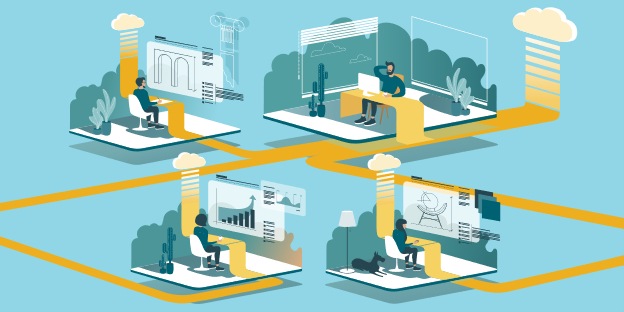Guest blog from Tom Sweeny at www.ServiceXRG.com
Geographically distributed teams are common for many industries and companies, but recent events have created the necessity for more individuals to work from home. For support and service operations that rely on centralized call centers the shift to a distributed workforce introduces new challenges – both technical and administrative. Here are some of the things to consider for effectively managing distributed support and success teams.
From Centralized to Distributed
The chatter of calls centers is distinctive, and the dynamics created by the personal proximity of dozens or even hundreds of service professionals is unique. Centrally located support teams create opportunities to develop relationships, develop skills and collaborate, often informally. The centralized nature of call centers also makes it easier to provide necessary infrastructure and security.
As more companies find that they need to send their workforce home and out of centralized call centers it is important to assure that teams remain focused and effective. For some, working remotely and being part of a distributed team is new. Here are some of the things to consider for effectively managing distributed support teams.
Team Objectives
The service mission persists. While some companies may see a decline in customer demand other sectors will find that they play a critical role in supporting vital operations in health care, logistics, communications, and other industries. It is imperative that everyone on the team understand the goals and the ways that they will contribute to the attainment of team objectives.
- Clearly define TEAM GOALS AND OBJECTIVES so that everyone understands the expected level of performance and desired outcomes. Share the big picture to the extent possible so that everyone understands the context for the team’s goals.
- Set clear INDIVIDUAL EXPECTATIONS with team members so that they know what is expected of them personally.
- Define the METRICS you will use to measure individual and team performance. Clearly describe to the team and individuals what the metrics are and how they will be used.
- Expand PERFORMANCE MANAGEMENT activities (check-ins, reviews, etc.) to help guide team members to meet their levels of performance. For individual that are new to working remotely there will be some challenges getting adjusted not to mention potential challenges due to infrastructure limitations.
- Create opportunities to COACH AND MENTOR individuals to help develop skills while working remotely.
Team Dynamics
Members of the team may be separated, but the team persists. Make certain that you maintain a team dynamic so that you can work towards common goals. Consider the following:
- DEFINE THE TEAM by introducing everyone. Although remote, relationships, collaboration and mutual support can persist. Update team photos in the company directory and if you don’t have one, consider making one.
- ENGAGE as a team and don’t allow team members to become “out-of-sight-out-of-mind.” Consider a more frequent cadence of team meetings through live meetings – encourage everyone to turn on their video.
- BUILD TRUST among team members that everyone will do their job and help achieve common objectives. Make certain that each team member knows their role and responsibilities.
- SUPPORT ONE ANOTHER as the shift from a centralized work environment to a remote location can be challenging for some.
Enablement
The ability for team members to conduct work remotely is important. Remote teams need access to core systems and tools to communicate and collaborate. Under some circumstances not all team members will be able to perform all the same functions they could do from within the company’s security infrastructure. Consider the following:
- Provide the necessary INFRASTRUCTURE for team members to access key systems.
- Assure that everyone on the team has the means to COLLABORATE AND COMMUNICATE This may require acquisition of video conferencing technologies and expanded licenses or enabling collaboration features within existing systems.
- Maintain SECURITY AND CONFIDENTIALITY For regulated industries the security and confidentiality of data that may be shared during a service interaction is essential. Assure that team members understand this and assure that remote infrastructure can meet required security and confidentiality protocols.
- Have a PLAN B. If team members cannot gain access to the necessary infrastructure to perform functions previous done within the company infrastructure, consider alternatives. Identify tasks that remote team members can perform with the tools and resoruces they have (develop new skills, write knowledge base articles, post to social platforms, etc.).
- Do what you can to KEEP THE TEAM WORKING.
Customer Expectations
Changes to the way your team works may have implications for customers. Set realistic expectations with customers if service availability or service levels will be affected. Consider the following:
- Let customers know if there will be any changes to SERVICE LEVELS AND AVAILABILITY.
- Communicate any changes to SERVICES DELIVERY including postponement of onsite engagements, or a request to change from submitting cases by phone to using electronic channels.
- KEEP CUSTOMERS UP TO DATE and they will be more willing and able to work with you.
About Service XRG
Service Excellence Research Group (ServiceXRG) helps companies retain customers, expand revenue, and achieve cost efficiencies through service excellence. Founded in 2004, we work with the world’s leading technology companies to transform and optimize service outcomes. We offer a portfolio of in-depth research and expert coaching services to help companies pursue Service Excellence and embrace Customer Success. Learn more at www.ServiceXRG.com.

